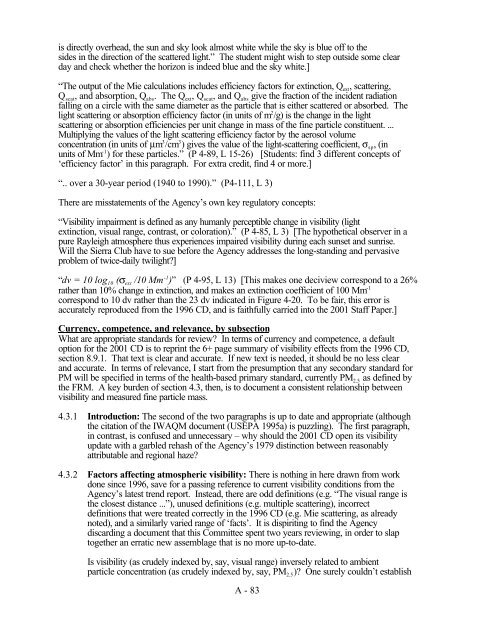Review of the Air Quality Criteria Document for Particulate Matter
Review of the Air Quality Criteria Document for Particulate Matter
Review of the Air Quality Criteria Document for Particulate Matter
- No tags were found...
You also want an ePaper? Increase the reach of your titles
YUMPU automatically turns print PDFs into web optimized ePapers that Google loves.
is directly overhead, <strong>the</strong> sun and sky look almost white while <strong>the</strong> sky is blue <strong>of</strong>f to <strong>the</strong>sides in <strong>the</strong> direction <strong>of</strong> <strong>the</strong> scattered light.” The student might wish to step outside some clearday and check whe<strong>the</strong>r <strong>the</strong> horizon is indeed blue and <strong>the</strong> sky white.]“The output <strong>of</strong> <strong>the</strong> Mie calculations includes efficiency factors <strong>for</strong> extinction, Q ext , scattering,Q scat , and absorption, Q abs . The Q ext , Q scat , and Q abs give <strong>the</strong> fraction <strong>of</strong> <strong>the</strong> incident radiationfalling on a circle with <strong>the</strong> same diameter as <strong>the</strong> particle that is ei<strong>the</strong>r scattered or absorbed. Thelight scattering or absorption efficiency factor (in units <strong>of</strong> m 2 /g) is <strong>the</strong> change in <strong>the</strong> lightscattering or absorption efficiencies per unit change in mass <strong>of</strong> <strong>the</strong> fine particle constituent. ...Multiplying <strong>the</strong> values <strong>of</strong> <strong>the</strong> light scattering efficiency factor by <strong>the</strong> aerosol volumeconcentration (in units <strong>of</strong> µm 3 /cm 3 ) gives <strong>the</strong> value <strong>of</strong> <strong>the</strong> light-scattering coefficient, σ sp , (inunits <strong>of</strong> Mm -1 ) <strong>for</strong> <strong>the</strong>se particles.” (P 4-89, L 15-26) [Students: find 3 different concepts <strong>of</strong>‘efficiency factor’ in this paragraph. For extra credit, find 4 or more.]“.. over a 30-year period (1940 to 1990).” (P4-111, L 3)There are misstatements <strong>of</strong> <strong>the</strong> Agency’s own key regulatory concepts:“Visibility impairment is defined as any humanly perceptible change in visibility (lightextinction, visual range, contrast, or coloration).” (P 4-85, L 3) [The hypo<strong>the</strong>tical observer in apure Rayleigh atmosphere thus experiences impaired visibility during each sunset and sunrise.Will <strong>the</strong> Sierra Club have to sue be<strong>for</strong>e <strong>the</strong> Agency addresses <strong>the</strong> long-standing and pervasiveproblem <strong>of</strong> twice-daily twilight?]“dv = 10 log 10 (σ ext /10 Mm -1 )” (P 4-95, L 13) [This makes one deciview correspond to a 26%ra<strong>the</strong>r than 10% change in extinction, and makes an extinction coefficient <strong>of</strong> 100 Mm -1correspond to 10 dv ra<strong>the</strong>r than <strong>the</strong> 23 dv indicated in Figure 4-20. To be fair, this error isaccurately reproduced from <strong>the</strong> 1996 CD, and is faithfully carried into <strong>the</strong> 2001 Staff Paper.]Currency, competence, and relevance, by subsectionWhat are appropriate standards <strong>for</strong> review? In terms <strong>of</strong> currency and competence, a defaultoption <strong>for</strong> <strong>the</strong> 2001 CD is to reprint <strong>the</strong> 6+ page summary <strong>of</strong> visibility effects from <strong>the</strong> 1996 CD,section 8.9.1. That text is clear and accurate. If new text is needed, it should be no less clearand accurate. In terms <strong>of</strong> relevance, I start from <strong>the</strong> presumption that any secondary standard <strong>for</strong>PM will be specified in terms <strong>of</strong> <strong>the</strong> health-based primary standard, currently PM 2.5 as defined by<strong>the</strong> FRM. A key burden <strong>of</strong> section 4.3, <strong>the</strong>n, is to document a consistent relationship betweenvisibility and measured fine particle mass.4.3.1 Introduction: The second <strong>of</strong> <strong>the</strong> two paragraphs is up to date and appropriate (although<strong>the</strong> citation <strong>of</strong> <strong>the</strong> IWAQM document (USEPA 1995a) is puzzling). The first paragraph,in contrast, is confused and unnecessary – why should <strong>the</strong> 2001 CD open its visibilityupdate with a garbled rehash <strong>of</strong> <strong>the</strong> Agency’s 1979 distinction between reasonablyattributable and regional haze?4.3.2 Factors affecting atmospheric visibility: There is nothing in here drawn from workdone since 1996, save <strong>for</strong> a passing reference to current visibility conditions from <strong>the</strong>Agency’s latest trend report. Instead, <strong>the</strong>re are odd definitions (e.g. “The visual range is<strong>the</strong> closest distance ...”), unused definitions (e.g. multiple scattering), incorrectdefinitions that were treated correctly in <strong>the</strong> 1996 CD (e.g. Mie scattering, as alreadynoted), and a similarly varied range <strong>of</strong> ‘facts’. It is dispiriting to find <strong>the</strong> Agencydiscarding a document that this Committee spent two years reviewing, in order to slaptoge<strong>the</strong>r an erratic new assemblage that is no more up-to-date.Is visibility (as crudely indexed by, say, visual range) inversely related to ambientparticle concentration (as crudely indexed by, say, PM 2.5 )? One surely couldn’t establishA - 83
















